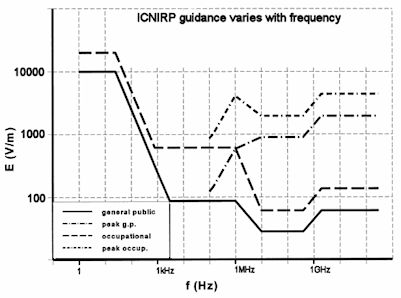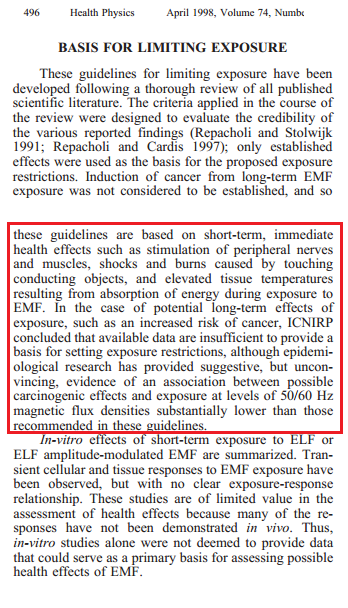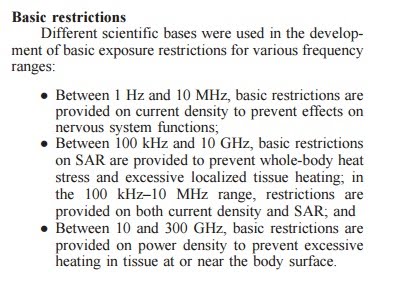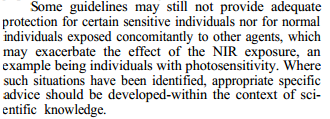Safety standards & recommendations, what are they, who determine them, on what basis, are they protecting us or industry & what do I think is safe.

Would you ever accept an air pollution safety standards, in which the air will be considered GOOD as long as you don’t choke and die from it on the spot?Would you ever accept an water quality standards that claim the water are “all OK” as long as you don’t dia few minutes after drinking them?
Well that is exactly the condition with the safety standards of exposure to EMF radiation. These so called “safety standards” are created by regulatory bodies that claim to be independent (such as the FCC and ICNIRP), while being heavily influenced by the industry.
Both RF and ELF standards are based only on short term immediate life rist effect such as the stimulation of currents over the nerves in ELF magnetic fields and tissue heat in high levels of RF radiation.
Actually the above standards are based on the theoretical assumption that non-ionizing radiation have no long term biological and health effect, and that the only influence that RF have is heat, and the only influence of EMF magnetic field is electric current being created over nerves (both in very high levels, much higher than the levels in which studies show biological change and damage).
On the base of these non protective high level, short term, so called safety standards, safety tests are done to cell phone, cell towers, antennas, infrastructure, appliances and wireless devices.
In these condition, the so called safety standards for non-ionizing radiation, protects the interest of the wireless and electricity industries, and do not protect the public.
Do you want to know more? You are in the right place!
In this chapter of the site we explain how these so called safety standards were created, by who, why and how it gain authority. In addition we will try to recommend our own safety levels for you to work by, that will be based on long term and biological effects.
EMF “Safety standards” not so safe
A Safety Standard is a problematic term. Safety standards are usually set by a committee of experts who tried to determine how much radiation is safe and how much is not safe. In the process of setting the standard many aspects, other than safety or health, are taking into consideration. For example: financial, technical and political aspects. Sometimes when you can not technically meet the standard, or meeting it will result in financial cost, the standard is gently shifted to please everyone and to save money. The international standards for low (ELF – used to be 1000 milliGauss, since 2005 it is 2000mG) and high frequency(RF – since the year of 1996 it is 1000-400 microWatts square centimeter) electromagnetic radiation are very high. Both takes into account only the immediate, obvious and permanent damage to the body and does not take into account any long-term health effect or biological effects. Some companies and organizations will use these outrageous high so called “safety standards”, without explanation of the true essence of it and its limitations.
ICNIRP(The committee that set the standards for most of the world) takes IEEE standards, approve them for all humans, to all age groups (the IEEE standards are usually for healthy professionals, in the working age), and recommend them to the WHO’s EMF study group(EMF Project). The EMF Study group then approve these standards and give them an “international” validity. Then the WHO’s EMF study group(EMF Project) introduce the standards as a recommendation to countries around the world. Most Countries embrace the WHO standards for EMF exposure of humans without any changes to it.
Both ICNIRP and the WHO’s EMF Study group are suspected in a conflict of interest.
- about EMF study group(EMF Project) conflict of interest
- about ICNIRP conflict of interest
- “unbalanced expert composition of the Main Commission of ICNIRP.” – Dariusz Leszezynski
- More info about WHO EMF PROJECT, ICNIRP, Michael Repacholi and Emilie van Deventer in this article from L. Hardel “World Health Organization, radiofrequency radiation and health – a hard nut to crack (Review)”- https://www.ncbi.nlm.nih.gov/pmc/articles/PMC5504984/
From ICNIRP Standards – page 496
“BASIS FOR LIMITING EXPOSURE –Only short term effect is covered!!!
“These guidelines for limiting exposure have been developed following a thorough review of all published scientific literature. The criteria applied in the course of the review were designed to evaluate the credibility of the various reported findings (Repacholi and Stolwijk 1991; Repacholi and Cardis 1997); only established effects were used as the basis for the proposed exposure restrictions. Induction of cancer from long-term EMF exposure was not considered to be established, and so these guidelines are based on short-term, immediate health effects such as stimulation of peripheral nerves and muscles, shocks and burns caused by touching conducting objects, and elevated tissue temperatures resulting from absorption of energy during exposure to EMF. In the case of potential long-term effects of exposure, such as an increased risk of cancer, ICNIRP concluded that available data are insufficient to provide a basis for setting exposure restrictions, although epidemiological research has provided suggestive, but unconvincing, evidence of an association between possible carcinogenic effects and exposure at levels of 50/60 Hz magnetic flux densities substantially lower than those recommended in these guidelines.“

On page 508 – What are the EMF standards are based on?

From the “ICNIRP STATEMENT” – Some people will not be protected
“Some guidelines may still not provide adequate protection for certain sensitive individuals nor for normal individuals exposed concomitantly to other agents….”

What good is the ICNIRP standard?
What good is this “safety standard” if most people are exposed to radiation levels lower than the safety standard, for several hours a day, every day for several years?
What good is this “safety standard” if an Electromagnetic hypersensitive person exposure to “safe” radiation levels causes him headaches, diabetes, neurological problems, epileptic seizures, chronic fatigue and trouble ills?
What good is this “safety standard” if for a person that was exposed to radiation levels lower than the “safety standard” but might still got cancer from this radiation?
What good is this “safety standard” if some studies showed damage to living cells at radiation levels 1000 times lower than the standard’s safe level?
There is one thing which the standard is always good for. It is very good and easy to use the “safety standard” as an excuse. Once in awhile companies and manufacturers of infrastructure, services and equipment that emit electromagnetic radiation (antenna, cell phone, cordless phone, high-voltage line, transformer and electric company) use it to show that their products are safe, or in order to dismiss claims of damages and health effect from victims. For example, there are several bodies that consider the very high safety standard of 1000 milliGauss (for low frequency electromagnetic radiation) as the only mandatory standard. One of them is the IEC (Israeli electric company) company that refers to this number as the only mandatory standard. Even if you submit them with test results showing radiation levels of 20 milliGauss , which comes from their facility, the IEC will argue that all is OK according to the “safety standard”. We all know that even for a short stay of half an hour, the radiation level of 20 milliGauss, is not recommended.

World map of EMF safety standards
The WHO published a map of safety standards in different countries across the world. The map does not always work and you need to enter each state to read about the different standards. Most the countries in the world are working according to the ICNIRP or FCC thermal so called safety standards. Some countries, especially old “east block” countries and Europeans countries have lower standards.
Press here to open the map in a new tab…
Safety standard and me
| Country/ body | RF safety standard mW/m2 (uW/cm2) | ELF Magnetic Field safety standard mG | ELF Electric field V/m | Comment |
| ICNIRP | 10000-4000 (1000-400) – Frequency depended | 2000 | 5000 (10000 for ocupantional) | Only immediate acute effect is tested. ICNIRP does not believe there is any biological long term effect, even in ELF where they were proven wrong in 2001 and in RF when they where proven wrong in 2011 , both when the WHO entered ELF and RF to the list of “possible carcinogenic in humans” |
| USA | ICNIRP | ICNIRP | ||
| CANADA | ICNIRP | ICNIRP | ||
| UK | ICNIRP | ICNIRP | ||
| AUSTRALIA | ICNIRP | ICNIRP | ||
| ISRAEL | Actual – ICNIRP. Environmental protection ministry Recommendation is 10% of ICNIRP Ministry of education recommendation is 1% of ICNIRP | Actual – ICNIRP. Environmental protection ministry Recommendation is not to pass public exposure average level for 24 hours of 4, and of a yearly average of 2. | The only legal standard in Israel is the ICNIRP standard, meaning 2000mG for ELF magnetic field and 400-1000uW/cm2 for RF. In RF they call the ICNIRP level “the Health threshold” . The ministry of environment protection issued a recommendation to keep pubic exposure less than 10% of ICNIRP, they call it “the environmental threshold”. The ministry of education recommends not to pass 1% of ICNIRP in schools. In ELF, the ministry of environment protection issued a recommendation to keep pubic exposure less than an yearly average of 2mG. The max “allowed” public average exposure for 24 hours is 4mG, Confused? I think all the above is meant to make you think they protect you, while they actually use the ICNIRP standards. | |
| INDIA | 10% of ICNIRP | ? | ||
| ITALY | 100 (10) | |||
| CHINA | 70-100 (7-10) | |||
| SWITZERLAND | 20-100 (2-10) | |||
| HUNGARY, BULGARIA, RUSSIA | 20-100(2-10) | |||
| Salzburg Austria | 0.1 | |||
| Recommended threshold by the BioInitiative report 2007 | 1 (0.1) | 2 | ||
| EU assembly | 1 (0.1) | http://assembly.coe.int/nw/xml/XRef/Xref-XML2HTML-en.asp?fileid=13137 | ||
| level which inflect Immediate pain on me (No Rad) | 1 (0.1) | 5 | 50 | Reference for EHS people, I an not the worst case of EHS. I know EHS people that are more sensitive than me. |
| level which inflect pain or discomfort after a few minutes on me (No Rad) | 0.05 (0.005) | 3 | 15 | Reference for EHS people, I an not the worst case of EHS. I know EHS people that are more sensitive than me. |
| My recommendation for non EHS | <0.04(0.004) | <2 | <10 | long term. Please note that biological influences appear also in levels lower than this level which should be considered as a compromise. |
| According to the 2011 BioInitiative report, below this level there is no biologic effect | <0.03 (0.003) | Please see “DEFINING A NEW ‘EFFECT LEVEL’ FOR RFR” “A scientific benchmark of 0.003 uW/cm2 or three nano-watts per centimeter squared for ‘lowest observed effect level’ for RFR is based on mobile phone base station-level studies.” at – http://www.bioinitiative.org/conclusions/) | ||
| BUILDING BIOLOGY recommendation for “slight concern” | 0.001-0.0001 (0.0001-0.00001) | 0.02-1mG | 1-5 V/m | |
| My recommendation for EHS people | <0.0005 (0.00005) | <1 | as low as possible <2 V/m | long term, some EHS people will need lower levels. |
| BUILDING BIOLOGY recommendation for “no concern” | <0.0001 (<0.00001>) | <0.02mG | <1 V/m |
Please notice that my recommendation have no legal validity and they are much more drastic than most other standards or recommendation. Since there is still no consensus about RF and ELF radiation health effects you need to determine, according to your understanding of the risk, the levels that you would like to follow.
EMF standards in ISRAEL
The standards here(Israel) are ICNIRP standards. There are also recommendations from the ministry of environment protection which are lower, but there are only recommendations.
The Recommendations
For RF 10% or ICNIRP 40-100uW/cm2, nice reduction (90% knock off from ICNIRP allowed levels) but still very very very very high. According to this standard and recommendation, the deployment of RF emitting devices is allowed almost everywhere and in whenever the RF tests (that are usually done using slow meters) show results lower than the recommendation.
The Safety distances from a cellular antenna are only a few meters, and cell phone antennas are sometimes installed as far as 10 meters from apartments, office buildings & other buildings.
Usually, whenever this recommendation is crossed, it is overlooked and the ICNIRP standard is then being used.
In schools, there is a regulation (from the ministry of education) to keep the RF levels as low as 1% of ICNIRP (4-10uW/cm2), which is also very high and still allow WIFI deployment and the use of wireless devices inside the schools (when tested with the wrong slow equipment). Usually, the 1% regulation is not used in official tests and documents, but even if it would be used the levels will be lower than 1% and still problematic (as the bioinitiative report shows that the bioeffect level of RF is as low as 0.003uW/cm2).
For ELF magnetic field, The Ministry of Environment Protection(MEP) recommendation is not to pass a daily Average of 4mG, and a yearly Average of 2mG. Both can’t be measured and are calculated according to the outcomes and predictions of the tests (number of exposure hours for each day, number of exposure days in a year, level of exposure when not in the main exposure place). The outcome of the existence of such rather low recommendations is that for the ELF Magnetic field, lower exposure levels are kept and if an official licenses professional tester will see levels higher than 2mG he will usually report them as “Not Good”. But still, exposure can become high for a worker (8 hours of 10mG is considered “OK” as the Yearly and Daily Averages are lower than recommended, and the assumption is that outside the working place the exposure of the worker is lower than 1mG) .
On the other hand, the Electric company in Israel regards the old ICNIRP standard of 1000mG to be “AOK”.
I might say that there is a kind of good infrastructure for regulation here in Israel. The field of EMF is lead by Prof’ Stelian Gelberg who leads the Noise and Radiation department in the Ministry of Environment Protection and who (kind of) acknowledge EHS and health effect for low EMF (both RF and ELF Magnetic). But he will not change the standard as long as the WHOs’ EMF PROJECT will not do so (and you know who run that, right?).
So as long as the official standards(not the recommendations) are high, everything is possible as far as deploying new RF emitting infrastructure and to further damage the health of people.
Official EMF Tester – showing you it is AOK
For doing RF and ELF safety surveys you need to have a license from the Ministry of Environment Protection which then regulates your work and reports. Most professional testers will think of levels of up to 2 uW/cm2 as close to nothing,. On the other hand, most professional testers will report levels of higher than 2mG as problematic. These testers are usually working with low sample rate meters, and usually use average functionality in RF. Most of the professional testers don’t know or understand EHS, and if they do know about it, most will consider it as not caused by EMF.
Please see – https://www.norad4u.com/measure/problems-limitations-in-profesional-tests/
Output level tracking for cell towers
In Israel, there is an automatic level report system for cell phone towers. Both for RF power output from most cellphone towers and antenna and also several 24X7 RF measuring devices(sampling rate once per 2 seconds) that are deployed in hot problematic places. But as long as the high standards are being enforced it produces “ALL OK” reports and is served as a means to calm the public down and to show that there is nothing to fear from.
